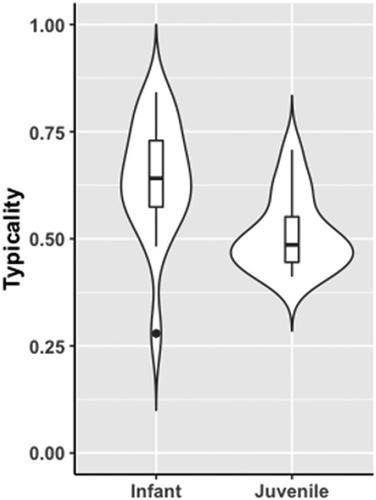当前位置:
X-MOL 学术
›
Am. J. Primatol.
›
论文详情
Our official English website, www.x-mol.net, welcomes your
feedback! (Note: you will need to create a separate account there.)
Filling in the gaps: Acoustic gradation increases in the vocal ontogeny of chimpanzees (Pan troglodytes)
American Journal of Primatology ( IF 2.0 ) Pub Date : 2021-04-01 , DOI: 10.1002/ajp.23249 Derry Taylor 1 , Guillaume Dezecache 2 , Marina Davila-Ross 1
American Journal of Primatology ( IF 2.0 ) Pub Date : 2021-04-01 , DOI: 10.1002/ajp.23249 Derry Taylor 1 , Guillaume Dezecache 2 , Marina Davila-Ross 1
Affiliation

|
Human vocal ontogeny is considered to be a process whereby a large repertoire of discrete sounds seemingly emerges from a smaller number of acoustically graded vocalizations. While adult chimpanzee vocal behavior is highly graded, its developmental trajectory is poorly understood. In the present study, we therefore examined the size and structure of the chimpanzee vocal repertoire at different stages of ontogeny. Audio recordings were collected on infant (N = 13) and juvenile (N = 13) semi‐wild chimpanzees at Chimfunshi Wildlife Orphanage, Zambia, using focal and ad libitum sampling. All observed call types were acoustically measured. These were predominantly grunts, whimpers, laughs, screams, hoos, and barks and squeaks. A range of spectral and temporal acoustic parameters were extracted, and fuzzy c‐means clustering was used to quantify the size and structure of the repertoire. The infant and juvenile vocal repertoires were both best described with the same number of clusters. However, compared to infants, juvenile call clusters were less distinct from one another and could be extracted only when a low level of overlap between call clusters was permitted. Moreover, the acoustic overlap between call clusters was significantly higher for juveniles. Overall, this pattern shows greater acoustic overlap in juvenile vocalizations compared to infants, suggesting a trend toward increased acoustic gradation in chimpanzee vocal ontogeny. This may imply in contrast to humans, chimpanzees become increasingly proficient in using graded signals effectively rather than developing a larger repertoire of more discrete sounds in ontogeny.
中文翻译:

填补空白:黑猩猩(Pan troglodytes)声音个体发育的声学渐变增加
人类声乐个体发育被认为是一个过程,在这个过程中,大量的离散声音似乎从较少数量的声学分级发声中出现。虽然成年黑猩猩的声音行为分级很高,但其发展轨迹却知之甚少。因此,在本研究中,我们检查了个体发育不同阶段黑猩猩声音曲目的大小和结构。收集了婴儿 ( N = 13) 和青少年 ( N = 13) 赞比亚 Chimfunshi 野生动物孤儿院的半野生黑猩猩,使用局部和随意采样。所有观察到的呼叫类型都进行了声学测量。这些声音主要是咕噜声、呜咽声、笑声、尖叫声、嘶嘶声、吠叫声和吱吱声。提取了一系列频谱和时间声学参数,并使用模糊 c 均值聚类来量化曲目的大小和结构。婴儿和青少年的声乐曲目都用相同数量的簇得到了最好的描述。然而,与婴儿相比,幼年的呼叫集群彼此之间的区别较小,只有在呼叫集群之间允许低水平重叠时才能提取。此外,幼鱼的呼叫簇之间的声学重叠明显更高。总体,与婴儿相比,这种模式在幼年发声中显示出更大的声学重叠,表明黑猩猩发声个体发育的声学等级有增加的趋势。这可能意味着与人类相比,黑猩猩越来越擅长有效地使用分级信号,而不是在个体发育中开发出更大的更离散的声音库。
更新日期:2021-04-29
中文翻译:

填补空白:黑猩猩(Pan troglodytes)声音个体发育的声学渐变增加
人类声乐个体发育被认为是一个过程,在这个过程中,大量的离散声音似乎从较少数量的声学分级发声中出现。虽然成年黑猩猩的声音行为分级很高,但其发展轨迹却知之甚少。因此,在本研究中,我们检查了个体发育不同阶段黑猩猩声音曲目的大小和结构。收集了婴儿 ( N = 13) 和青少年 ( N = 13) 赞比亚 Chimfunshi 野生动物孤儿院的半野生黑猩猩,使用局部和随意采样。所有观察到的呼叫类型都进行了声学测量。这些声音主要是咕噜声、呜咽声、笑声、尖叫声、嘶嘶声、吠叫声和吱吱声。提取了一系列频谱和时间声学参数,并使用模糊 c 均值聚类来量化曲目的大小和结构。婴儿和青少年的声乐曲目都用相同数量的簇得到了最好的描述。然而,与婴儿相比,幼年的呼叫集群彼此之间的区别较小,只有在呼叫集群之间允许低水平重叠时才能提取。此外,幼鱼的呼叫簇之间的声学重叠明显更高。总体,与婴儿相比,这种模式在幼年发声中显示出更大的声学重叠,表明黑猩猩发声个体发育的声学等级有增加的趋势。这可能意味着与人类相比,黑猩猩越来越擅长有效地使用分级信号,而不是在个体发育中开发出更大的更离散的声音库。











































 京公网安备 11010802027423号
京公网安备 11010802027423号